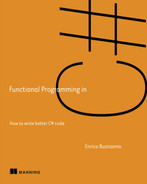Part 2. Core techniques
In this part, we’ll look at some of the most common techniques used in FP. You’ll see how simple constructs and techniques enable you to solve problems with succinct, elegant, and readable code.
Chapter 4 deals with principles for designing types and function signatures—things you thought you knew, but you’ll see them in a new light when looking at them from a functional perspective.
Chapter 5 shows you the reason and implementation for the Option type, a staple of FP that is not only useful in itself but will guide you in understanding many subsequent concepts throughout the book.
Chapter 6 introduces some of the core functions of FP: Map, Bind, ForEach, and Where. These functions provide the basic tools for interacting with the most common data structures in FP.
Chapter 7 shows how functions can be chained into pipelines that capture the workflows of your program. It then widens the scope to developing a whole use case in a functional style.
By the end of part 2, you’ll have a good feel for what a program written in a functional style looks like. You’ll also be able to apply FP ideas and constructs in your own code—on a small scale—creating islands of functional code within a sea of OO code.
